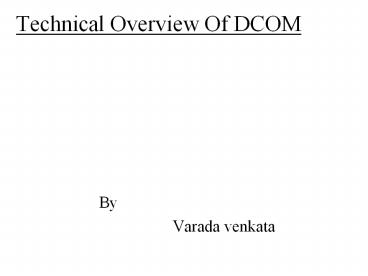Technical Overview Of DCOM - PowerPoint PPT Presentation
1 / 20
Title:
Technical Overview Of DCOM
Description:
DCOM handles low-level details of network protocols allowing us to focus on the ... DCOM solves the problems associated with distributed applications ... – PowerPoint PPT presentation
Number of Views:176
Avg rating:3.0/5.0
Title: Technical Overview Of DCOM
1
Technical Overview Of DCOM
- By
- Varada venkata
2
Contents
- Introduction
- Why distributed applications?
- DCOM architecture
- Design issues addressed by DCOM
- Summary
3
Introduction
- DCOM extends COM
- Supports communications among objects on
different computers - Applications can be distributed at locations
that make sense to the customer and to the
application - DCOM handles low-level details of network
protocols allowing us to focus on the business
aspects - DCOM solves the problems associated with
distributed applications
4
Why to write distributed applications ?
- Some applications are inherently distributed.
- Applications designed with distribution in mind
can accommodate different clients with different
capabilities. - Designing applications for distribution provides
flexibility in deployment
5
DCOM Architecture
Com component in the same process
6
DCOM Architecture
- Com runtime Provides object oriented services
to the clients and components - RPC and security provider Generate standard
network packets that conform to the DCOM
wire-protocol standard
7
Design issues in DCOM
- COMPONENTS AND REUSE
- DCOM directly and transparently takes advantage
of any existing in COM components and tools
LOCATION INDEPENDENCE
- Design constraints while implementing Distributed
Applications - Components that interact should be close to each
other - Some components can run on specific machines or
at specific loc - Smaller comps increase flexibility of
deployment,inc ntwk traffic - Larger comp reduce ntwk traffic, reduce
flexibility of deployment
8
Location independence
- DCOM completely hides the location of the
component - If applications have numerous small components ,
reduce ntwk loading by deploying them on same
LAN segment, or on same machine - If application have small number of large
components , put them on the faster machines
available , less scope of network loading
9
Language neutrality
- As an extension of com ,DCOM is completely
language- independent - Developers can choose the tools and languages
that are familiar with - CONNECTION MANAGEMENT
- DCOM manages connection to components by
maintaining a reference count - DCOM uses efficient pinging protocol
- DCOM provides a robust distributed garbage
collection mechanism that is transparent to the
application - DCOM provides unidirectional client-server
interaction and also rich , interactive
communication between clients and servers
10
SCALABILITY
- DCOM provides a number of features that enhance
appls scalability - SMP(symmetric multiprocessing)
- DCOM takes advantage of the Win NT support for
multiprocessing. - DCOM shields the details of thread management and
delivers the optimal performance. - FLEXIBLE DEPLOYMENT DCOM location
independence enables it to distribute components
over other computers - Ex?
- Efficient performance for a server
is to handle 50 components. - No of users 200,
- when no of users 400 , no of components 70,
- Deploy 30 components on second server, 20 are on
both, 20 on first.
11
SCALABILITY
12
Versioning
- Com component can appear differently to different
clients . - A client that uses a certain feature needs to
access only the methods and properties that it
uses.
13
The broker component keeps track of the pool of
the server machine running identical components
The broker measure the current load on the
server and detects when servers are added or
removed.
14
Performance
- Vtable
- RPC infrastructure when client and components are
not actually close. - The overall performance and scalability
advantages of DCOM can be reached by implementing
thread-pool managers and pinging protocols - BANDWIDTH AND LATENCY
- Bandwidth The size of the parameters passed
into a method call directly affects the time it
takes to complete the call - Latency The physical distance and the number
of network elements involved delay even the
smallest data packet . - DCOM minimizes the network round trips to avoid
impact of latency. - DCOM preferred transfer protocol is the
connection less UDP subset of the TCP/IP protocol
suite . - This connectionless nature of this protocol
allows DCOM to perform several optimizations by
merging many packages with data and pinging msgs
15
Security
DCOM stores Access control list for components
16
Programmatic control over security
17
Load Balancing
- Static load balancing
- Permanently assign certain users to certain
servers running the same application. - Dynamic load balancing
- Reference component decides which server has
less load. It chooses the server having less load
and deploys the component.
18
Protocol Neutrality
- DCOM makes sure that the application is
independent of the underlying network infra
structure. - DCOM uses any transport protocol, including
TCP/IP ,UDP. - DCOM provides security framework on all of these
protocols , including connectionless and
connection-oriented protocol.
19
Summary
- DCOM makes it easy to write a distributed
application that - scales from single computer environment in to
biggest pool of server machines - Can be robustly expanded to meet new functional
requirements - Uses network bandwidth carefully, while providing
great response time for the end users - Is inherently secure
- Provides a smooth migration path to sophisticated
load balancing - Can be used with any network protocol and
integrated into any hardware platform
20
References
- "DCOM Architecture"
- "DCOM Solutions in Action" (MSDN Library,
Conference Papers, PDC 97 Conference Papers) - The Component Object Model Specification (MSDN
Library, Specifications) - Distributed Component Object Model Protocol
DCOM/1.0 (MSDN Library, Specifications) - COM Technologies Home Page at http//www.microsoft
.com/com/comintro.htm - Introduction to DCOM (http//devcentral.iftech.co
m/articles/DCOM/intro_DCOM/part1/default.php_































